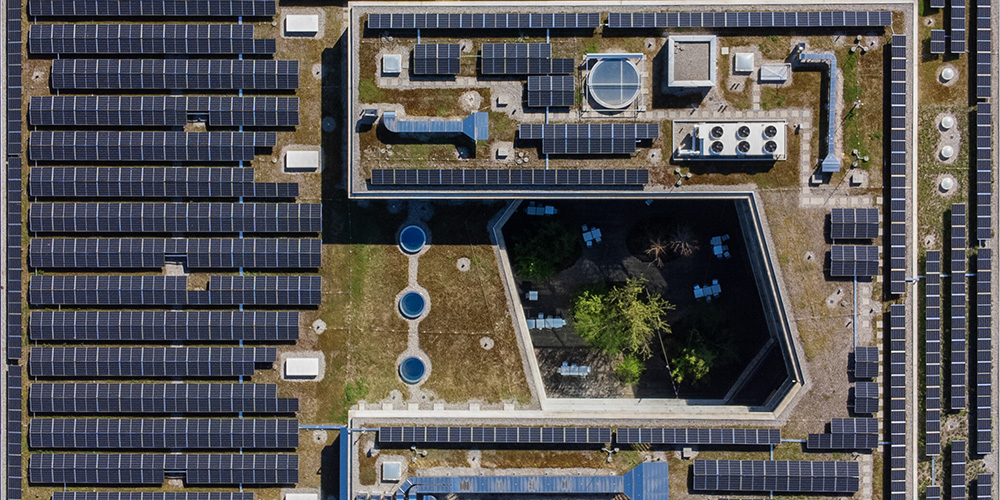Cutting-edge research and resource conservation for a sustainable university
The University of Basel’s Sustainability Report for the years 2023/2024 shows that many students, researchers and staff got involved once again in the cause of greater sustainability. Nevertheless, the university’s greenhouse gas emissions increased in 2023/2024 – primarily due to increased air travel following the pandemic.
22 May 2025 | Samuel Schlaefli
The Sustainability Report, which is published every two years, is the University of Basel’s central tool for highlighting sustainability activities, monitoring key figures and strengthening its internal sustainability culture. The new Sustainability Report 2023/2024 also reports for the first time on the status quo of the climate strategy adopted in spring 2024, which aims to reduce the university’s emissions by 35 percent by 2030 compared to the base year 2019.
In 2024, total emissions were 20 percent lower than in 2019. At 7,084 tons of CO2 equivalents for 2023 and 7,725 tons of CO2 equivalents for 2024, emissions last year were around 10 percent higher than in 2022 (6,983 tons of CO2 equivalents). The increase is mainly due to the increase in aviation emissions.
The number of flights again increased significantly compared with the previous reporting period, with 5,425 flights in 2023 and 6,113 flights in 2024. This means that last year, the goal set by the President’s Office of a 30 percent reduction in comparison with the 2017–2019 baseline was not achieved for the first time. However, some faculties and departments have taken ambitious measures to reduce their flight emissions by up to 80 percent compared to the baseline.
The latest Sustainability Report documents our progress toward becoming an institution that fulfills its responsibility to the climate. Our aim is to design the infrastructure in such a way that it is ecologically and economically viable in the long term, while at the same time providing excellent conditions for research and teaching.
Dr. Rolf Borner, Director of Infrastructure and Operations
Research to support the energy transition
In terms of research, many sustainability-related projects have been implemented and the results of this research published in recent years. For example, a study by Professor Ben Engel on the discovery of a protein shell that plays a key role in CO2 fixation by diatoms attracted widespread international attention. The results are valuable in terms of biotechnological methods for CO2 storage.
The “Sustainable Future” research network, which brings together over 100 researchers from five faculties, continues to play an important role in interdisciplinary collaboration. As part of the national funding program “SWEET,” the research network is involved in two major research collaborations on the Swiss government’s Energy Strategy 2050.
Bringing sustainability to life for students and the public
The curriculum at the University of Basel enables students to prepare themselves for global challenges and promotes their ability to identify and assess sustainable development problems in their specific contexts. Over the past two years, sustainability-related courses have increasingly been offered across borders as part of the university alliances Eucor and EPICUR.
Many committed students have also implemented numerous sustainable projects outside of their teaching. In addition to the Sustainability Weeks in 2023 and 2024, which once again enjoyed success, the Action Group Nachhaltigkeit (AG Nachhaltigkeit) organized various workshops, information stands and panel discussions on the topic of sustainability for university members and the general public. Drawing on its position as a member of various national and international networks, the University of Basel also continues to promote public dialog and transdisciplinary collaboration.
Green roofs for more biodiversity
For the first time, the Sustainability Report also includes the “Resilient Campus” section, which addresses topics such as biodiversity. A lot has happened in this respect in recent years: more than 1,400 m2 of roofs were covered with ecologically valuable plants on both university-owned sites and sites used by the university. These habitats were supplemented in 2024 by the creation of green spaces in front of the Biozentrum and the University Library. In new buildings, such as the Department of Biomedicine building, infiltration systems were also incorporated into the plans in order to keep water in the local water cycle.
Recyclable materials monitoring revealed that the total amount of waste and recyclable materials generated remained unchanged in 2023 and 2024, at 563 and 562 tons, respectively. On the other hand, the amount of hazardous waste decreased while that of recyclable materials increased. A total of around 89 tons of hazardous waste was generated in 2023 and around 69 tons in 2024.
Various pilot projects were carried out to extend the useful life of furniture and IT devices. For example, Campus Services have been preparing to sell discarded furniture that is no longer used on campus. Since 2024, IT-Services has also been working to examine various options for the resale of obsolete IT devices as part of a pilot project.


